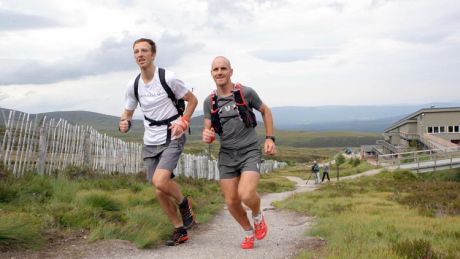How to train for off-road races: 5 top tips
Advice on how to prepare your body and your legs for the toughest long distance pursuits

Merrell Ambassador Dr. Andrew Murray and Scottish running coach and endurance runner Donnie Campbell recently ran the 10 highest peaks in Britain in a record 13hours and 10minutes. Here are their top tips on training for major off-road pursuits.
Build Your Miles
The key for getting your legs used to ultra marathon mileage is simply putting in the miles. The number of miles you run each week can be easily recorded by many Smartphone apps whilst make sure that your longer runs are done at a pace where you can hold steady conversation and where your heart is working at no more than 70% of its maximum.
As a guide start by increasing your weekly mileage by 5-10% each week focusing on logging the extra miles during your long run . Be sure to keep these runs specific to the event you're taking part in, if it’s a flat run, train on the flat but if it’s a hilly run train on slopes. Try and avoid running on asphalt as much as possible to reduce the risk of repetitive impact injuries.
N.B. Andrew was building upon a remarkably good base fitness level so we started by running around 5 hours for his long run the first week and building up from there.
Hill Sprints
To build power in your legs, increase your VO2 max. To prepare the body for the unpredictable nature of the highlands and ascending mountains at speed Andrew was prescribed prolonged hill sprint sessions lasting 45 minutes to an hour, once each week.
To replicate these sessions yourself scout your local environment to find a steep gradient and perform circuits by sprinting up the hill at 90-100% for 1-2 minutes followed by a recovery walk or jog back down the hill. Placing such physical demand on your body will quickly build your VO2 max.
Tempo Sessions
These are again best run over similar terrain, as you’ll be facing on the day of your event. For this you'll be looking to run close to your race pace for 10k for 45mins to an hour, helping push your lactic threshold. Tempo running is part of the staple training plan of many Kenyan distance runners and whilst Andrew, as a resident of Edinburgh, benefitted from having an array of varied terrain ready for him to tackle, runners should look to travel where possible to keep their training novel and exciting.
Get the Coach Newsletter
Sign up for workout ideas, training advice, reviews of the latest gear and more.
Concentrate on your core and balance
Andrew was set a challenge to set aside half an hour 2 times a week to perform a series of core exercises using medicine balls and kettle bells to fire up the power in his glutes and core muscles. The reason for this is that the glutes provide the power for an athlete to tackle steep terrain and the core is essential to stay balanced and keep good running form over technical trails.
- An example workout could be as follows:
- Complete a circuit workout by combining 20 one legged squats with kettle bells on each leg (helping to build strength and balance)
- 20 squat jumps with kettlebells (to help build dynamic power)
- One minute plank and 30 sit-ups with a twist and 30 back raises (to work not just your abdominals but the oblique and lumbar regions)
- Rest for 30 -60 seconds after each set, repeat the circuit 3 times.
Nutrition is key
You can't out train a bad diet. This expression is particularly relevant in a society where a growing number of people are competing in grueling endurance races along with working a steady 9-5 job. Learning from the Elite Kenyan runners again, you should be looking to fuel your body with carbohydrates as that is your bodies preferred energy source, more specifically, complex carbohydrates such as whole grains and fresh fruit and vegetables, also you need some lean protein in your diet to help repair damaged muscle tissue from training and some natural fats to aid body function..
N.B. During the peak of Andrew’s training for the Big 10 he was exercising for around 20-30 hours a week which meaning that he constantly needed to make the right food choices or risk dangerous energy deficits when training.
Dr Andrew Murray is a Merrell Pack leader, shop his kit via http://www.merrell.com
